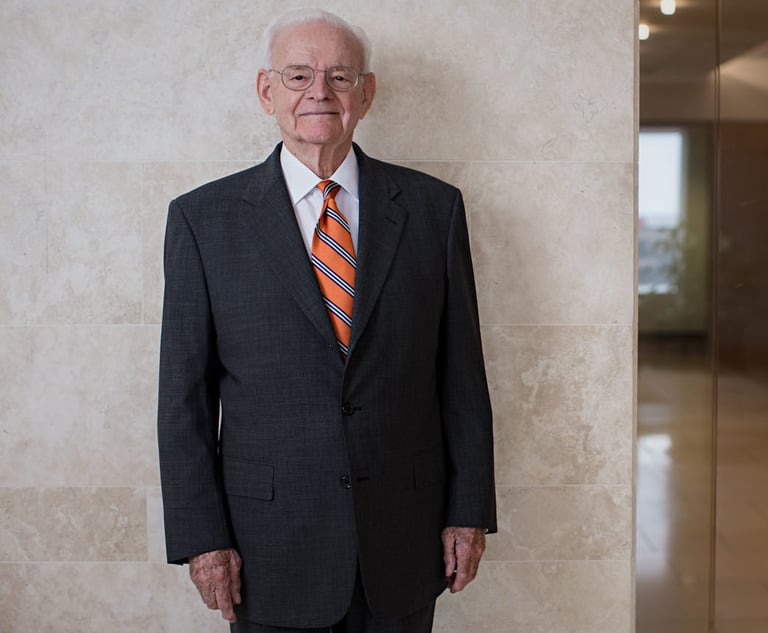Commonwealth Court Tackles Whether ZBA Committed an Error in 'Renaissance' Decision
The Commonwealth Court of Pennsylvania recently determined whether the city of Philadelphia's Zoning Board of Adjustment (ZBA) committed an error of law by refusing to allow a property owner to replace a nonconforming, but legally authorized, multifamily dwelling with a new one.
December 10, 2018 at 01:16 PM
7 minute read
 Alan Nochumson.
Alan Nochumson.
In Renaissance Real Estate Holdings v. City of Philadelphia Zoning Board of Adjustment, 2018 Pa. Commw. LEXIS 699 (Dec. 6, 2018), the Commonwealth Court of Pennsylvania recently determined whether the city of Philadelphia's Zoning Board of Adjustment (ZBA) committed an error of law by refusing to allow a property owner to replace a nonconforming, but legally authorized, multifamily dwelling with a new one.
In Renaissance Real Estate Holdings, the property owner purchased a property located in Roxborough, Philadelphia, which consisted of a three-unit building structure on a 3,740 square-foot, mid-block lot.
Prior to its purchase of the property, the property owner received a certification statement issued by the city of Philadelphia's Department of Licenses and Inspections (L&I) which provided that the property was legally registered for use as a three-family dwelling.
The certification statement also confirmed that property's zoning classification was RSA-3. Under the zoning code promulgated by the city of Philadelphia, the term RSA stands for residential single-family attached.
After its purchase of the property, although the building structure was not occupied at the time, the property owner nonetheless obtained a rental license allowing it to rent the three-family dwelling located on the property.
The property owner subsequently applied for a zoning permit with L&I to demolish the preexisting three-unit building and replace it with a new, slightly larger one.
After reviewing the zoning permit application, L&I determined that the proposed use did not meet the zoning code's requirements because multifamily dwellings are not permitted in the RSA-3 district, the size of side yard width was too small, and the property owner did not provide for the allotted amount of parking spaces for the property, as required under the zoning code.
As a result, L&I issued a notice of refusal in response to the zoning permit application and the property owner appealed L&I's notice of refusal to the ZBA.
In its application for appeal submitted to the ZBA, the property owner stated that the existing structure was affected by substantial structural defects and, thus, needed to be replaced by a new one.
A hearing took place before the ZBA.
During the hearing, the property owner's architect testified that the new structure's footprint would be “slightly different” than that of the existing building in that it would have a five-foot side yard as opposed to the existing four-foot side yard, and it would be “slightly deeper in depth than the existing building.”
In addition, the property owner's representative testified during the hearing that he inspected the property before the purchase and the building structure was “in pretty poor condition” and the certification statement revealed a multitude of violations against the property.
The property owner's representative stated that the property owner “'initially intended to clean up the violations and to renovate the building' but after 'adding the numbers up, and doing it to the standards that he had for renovation, it made more sense to possibly start from scratch.'”
During the hearing, the property owner's counsel argued that, although multifamily dwellings are not permitted in the RSA-3 district, no use variance was required because the proposed three-family dwelling is a lawful nonconforming use that may be continued by right, even in a replacement structure.
At the conclusion of the hearing, the ZBA denied the property owner's appeal of the notice of refusal issued by L&I.
The ZBA concluded that the proposed multifamily dwelling was not permitted as a continuation of a nonconforming use.
Citing to Section 14-305 of the zoning code, the ZBA noted the difference between “rights following destruction” and “voluntary destruction.”
Under Section 14-305(10)(b) of the zoning code, titled 'Rights Following Destruction', a nonconforming building or use that is “destroyed or rendered unusable by fire or an act of God or a third party over which the owner has no control” may be reconstructed or resumed so long as, among other things, the replacement structure “does not reduce the nonconforming setbacks or exceed the nonconforming area or height of the destroyed structure may be constructed.”
Under Section 14-305(10)(c) of the zoning code, titled 'Voluntary Destruction', “any nonconforming structure, use, lot, parking area, site improvement or accessory sign destroyed through means other than by fire or act of God or a third party over which the owner has no control shall be reconstructed in compliance with the Zoning Code for the zoning district where it is located.”
The ZBA determined that demolition of the existing structure on the property would be deemed a “voluntary destruction” of the preexisting structure, resulting in extinguishment of the prior three-family use, and any subsequent development would be required to comply with the RSA-3 district's standards, which do not permit multifamily dwellings.
The property owner appealed the ZBA's decision to the trial court.
Without taking additional evidence, the trial court affirmed the ZBA's decision and the property then appealed the trial court's ruling to the Commonwealth Court.
On appeal, the property owner argued that the ZBA erred in determining that the zoning code prohibits the replacement of an existing, lawful nonconforming use.
The property owner provided that the portions of Section 14-305 of the zoning code cited by the ZBA in reliance upon its decision did not apply because the structure was not voluntarily or otherwise destroyed.
Citing to Zeiders v. Zoning Hearing Board of Adjustment of West Hanover Township, 397 A.2d 20 (Pa. Cmwlth. 1979), the property owner pointed out that, while a municipal ordinance may prohibit reconstruction of a nonconforming building structure, “such restrictions must be specifically stated” and “in their absence, an owner seeking to continue a valid non-conforming use must be permitted to do so.”
Relying Amoco Oil v. Ross Townhsip Zoning Hearing Board, 426 A.2d 728 (Pa. Cmwlth. 1981) and Trettel v. Zoning Hearing Board of Harrison Township, 658 A.2d 741 (Pa. 1995), the property owner emphasized that, absent a specifically stated restriction, Pennsylvania courts allow owners to demolish and reconstruct.
In other words, according to the property owner, because the cited sections of the zoning code do not specifically prohibit rebuilding a nonconforming structure, it should not be prohibited from doing so under the circumstances.
Because the property owner's proposal contemplated demolition of the existing, nonconforming structure, the Commonwealth Court concluded that no error was apparent in the ZBA's determination that such demolition would extinguish the property owner's right to reconstruct a multifamily dwelling on the property.
The Commonwealth Court emphasized that the property owner's argument that it is entitled to rebuild the structure because it has not yet demolished the existing structure is flawed given that the property owner sought permission from the ZBA to do just that.
As a result, the Commonwealth Court held that any reconstruction required compliance with zoning code provisions for the RSA-3 district, which does not permit multifamily dwellings.
Alan Nochumson is the sole shareholder of Nochumson P.C., where his law firm's primary practice areas consist of real estate, litigation, land use and zoning, business formation and general counseling and appellate advocacy. He is also president of Bear Abstract Services, where his title insurance company offers comprehensive title insurance, title examination and closing services. He can be reached at 215-399-1346 or [email protected].
This content has been archived. It is available through our partners, LexisNexis® and Bloomberg Law.
To view this content, please continue to their sites.
Not a Lexis Subscriber?
Subscribe Now
Not a Bloomberg Law Subscriber?
Subscribe Now
NOT FOR REPRINT
© 2025 ALM Global, LLC, All Rights Reserved. Request academic re-use from www.copyright.com. All other uses, submit a request to [email protected]. For more information visit Asset & Logo Licensing.
You Might Like
View All
Commonwealth Court Overturns Award of Damages Assessed Against Landlord on Claims of Unlawful Discrimination
6 minute read

Judge Louis C. Bechtle: An American Jurist Who Relied on Common Sense, Sound Judgment and Fairness
5 minute read
Six Ways Thought Leadership Can Support Your Law Firm’s 2025 Strategic Plan
6 minute readTrending Stories
- 1'It's Not Going to Be Pretty': PayPal, Capital One Face Novel Class Actions Over 'Poaching' Commissions Owed Influencers
- 211th Circuit Rejects Trump's Emergency Request as DOJ Prepares to Release Special Counsel's Final Report
- 3Supreme Court Takes Up Challenge to ACA Task Force
- 4'Tragedy of Unspeakable Proportions:' Could Edison, DWP, Face Lawsuits Over LA Wildfires?
- 5Meta Pulls Plug on DEI Programs
Who Got The Work
Michael G. Bongiorno, Andrew Scott Dulberg and Elizabeth E. Driscoll from Wilmer Cutler Pickering Hale and Dorr have stepped in to represent Symbotic Inc., an A.I.-enabled technology platform that focuses on increasing supply chain efficiency, and other defendants in a pending shareholder derivative lawsuit. The case, filed Oct. 2 in Massachusetts District Court by the Brown Law Firm on behalf of Stephen Austen, accuses certain officers and directors of misleading investors in regard to Symbotic's potential for margin growth by failing to disclose that the company was not equipped to timely deploy its systems or manage expenses through project delays. The case, assigned to U.S. District Judge Nathaniel M. Gorton, is 1:24-cv-12522, Austen v. Cohen et al.
Who Got The Work
Edmund Polubinski and Marie Killmond of Davis Polk & Wardwell have entered appearances for data platform software development company MongoDB and other defendants in a pending shareholder derivative lawsuit. The action, filed Oct. 7 in New York Southern District Court by the Brown Law Firm, accuses the company's directors and/or officers of falsely expressing confidence in the company’s restructuring of its sales incentive plan and downplaying the severity of decreases in its upfront commitments. The case is 1:24-cv-07594, Roy v. Ittycheria et al.
Who Got The Work
Amy O. Bruchs and Kurt F. Ellison of Michael Best & Friedrich have entered appearances for Epic Systems Corp. in a pending employment discrimination lawsuit. The suit was filed Sept. 7 in Wisconsin Western District Court by Levine Eisberner LLC and Siri & Glimstad on behalf of a project manager who claims that he was wrongfully terminated after applying for a religious exemption to the defendant's COVID-19 vaccine mandate. The case, assigned to U.S. Magistrate Judge Anita Marie Boor, is 3:24-cv-00630, Secker, Nathan v. Epic Systems Corporation.
Who Got The Work
David X. Sullivan, Thomas J. Finn and Gregory A. Hall from McCarter & English have entered appearances for Sunrun Installation Services in a pending civil rights lawsuit. The complaint was filed Sept. 4 in Connecticut District Court by attorney Robert M. Berke on behalf of former employee George Edward Steins, who was arrested and charged with employing an unregistered home improvement salesperson. The complaint alleges that had Sunrun informed the Connecticut Department of Consumer Protection that the plaintiff's employment had ended in 2017 and that he no longer held Sunrun's home improvement contractor license, he would not have been hit with charges, which were dismissed in May 2024. The case, assigned to U.S. District Judge Jeffrey A. Meyer, is 3:24-cv-01423, Steins v. Sunrun, Inc. et al.
Who Got The Work
Greenberg Traurig shareholder Joshua L. Raskin has entered an appearance for boohoo.com UK Ltd. in a pending patent infringement lawsuit. The suit, filed Sept. 3 in Texas Eastern District Court by Rozier Hardt McDonough on behalf of Alto Dynamics, asserts five patents related to an online shopping platform. The case, assigned to U.S. District Judge Rodney Gilstrap, is 2:24-cv-00719, Alto Dynamics, LLC v. boohoo.com UK Limited.
Featured Firms
Law Offices of Gary Martin Hays & Associates, P.C.
(470) 294-1674
Law Offices of Mark E. Salomone
(857) 444-6468
Smith & Hassler
(713) 739-1250





